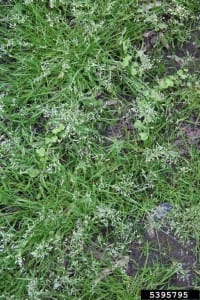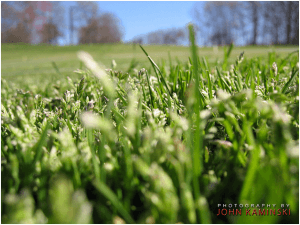Clint Waltz and Patrick McCullough, Turfgrass Specialist and Weed Specialist, University of Georgia

Annual bluegrass (Poa annua L.) is a troublesome winter annual weed in residential turf. Compared to most turfgrasses, annual bluegrass has a lighter green color, coarser leaf texture, and produces unsightly seedheads.
Annual bluegrass seed germinates throughout the late-summer and early-fall once soil temperatures drop below 70° F. Seedlings grow and mature in fall, overwinter in a vegetative state, and produce seed in spring. A second germination can occur in late-winter as soil temperatures rise and the days become longer.
Annual bluegrass is a prolific seed producer and individual plants may produce hundreds of viable seed, even when closely mowed. Annual bluegrass flowers over several months in spring and produces seed that may remain dormant in soil for years before germinating. Annual bluegrass often dies from summer stresses but may survive in protected sites that receive irrigation. Controlling annual bluegrass in mid- to late-spring in residential lawns can be difficult.

Control in bermudagrass and zoysiagrass
Up until mid-February (when the bermudagrass was fully dormant) applying a glyphosate containing product (e.g. Roundup) was an option for postemergence annual bluegrass control. Even then, care must be taken not to “overdose” the weed and harm the bermudagrass. Applicators commonly over-spray the weed with glyphosate and some herbicide moves deep into the bermudagrass canopy where it contacts green bermudagrass stolons near the ground. Any green part of the plant in the bermudagrass can absorb the glyphosate which can damage the plant.
It is now too late and risky to consider spraying glyphosate to control annual bluegrass in dormant bermudagrass. While bermudagrass may still look “completely” dormant it is starting to greenup and the application of glyphosate during greenup can damage the turf. Do not apply glyphosate to dormant grass of any type other than bermudagrass since other grasses never really go completely dormant and may be damaged by the herbicide.
There are a few selective herbicidal options to control annual bluegrass at this point in the season. In bermudagrass and zoysiagrass, if the annual bluegrass population is bad enough the best option is treating with either Revolver (foramsulfuron) or Monument (trifloxysulfuron).
Control in centipedegrass and St. Augustinegrass
Neither of these herbicides is labeled for use on centipedegrass or St. Augustinegrass. In centipedegrass and St. Augustinegrass, atrazine containing products are an option but large annual bluegrass grass plants are difficult to control with a single application.
The weed is an annual cool-season grassy weed that will die-out in a couple months as temperatures warm. For now, having patience and tolerance maybe the best option. Plan for next winter and spring. Begin with good turfgrass cultivation this summer. For example:
- Deep and infrequent irrigation encourages turfgrass root development which improves the ability of the lawngrass to compete with weeds.
• Identify and alleviate soil compaction since annual bluegrass prefers compacted soils. For rapid recovery and improved vigor, core aerifications should be performed during the active growth period of warm-season turfgrasses.
• Mow the lawn at the appropriate height for the grass species. Lower mowing heights may stress turf and reduce its ability to compete with annual bluegrass. For proper mowing height recommendations, visit www.GeorgiaTurf.com
• Lastly, begin a preemergence herbicide program in late-summer to help control the seed that were deposited this season.
Landscapers can help homeowners with controlling annual bluegrass now and planning a healthier lawn to prevent annual bluegrass next year.
